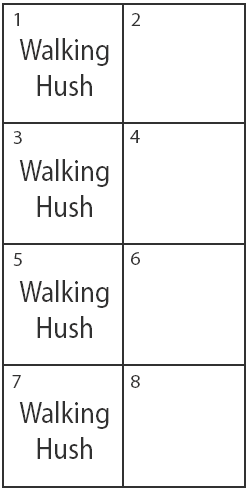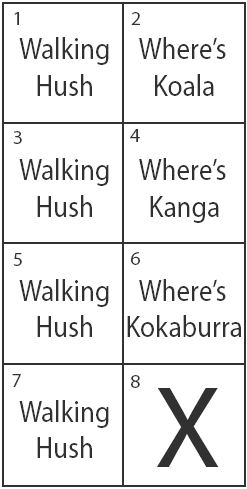Music Magic
Main Core Tie
English Language Arts Grade 1
Reading: Literature Standard 2
Summary
This lesson provides music and drama activities to help students improve their comprehension skills.
Materials
Attachments
Websites
- Phil Tulga - Music Through the Curriculum
Interactive Web site to use as a teacher resource or learning center for students - StinaLisa
Great musical stories to use from your PC
- Several familiar songs that can be hummed without music, e.g., Wheels on the Bus, This Old Man, etc.
- Let's Make Music! An Interactive Musical Trip Around The World CD
- My Music Magic Performance self assessment
- Musical Storyboard
- Boomerang Clapper
- Animal Props
Additional Resources
Books
- The Power of Retelling -- Developmental Steps for Building Comprehension, by Vicki Benson and Carrice Cummins; ISBN 0-322-01541-3
- Piggyback Songs for School, by Jean Warren; ISBN 0-911019-44-8
Additional Media
- Let's Make Music! An Interactive Musical Trip Around The World, by Jessica Baron Turner (available from KIDiddles, http://www.kididdles.com/); Item HL00815057-CD.
Background for Teachers
Teach the comprehension strategy of retelling. Use storyboarding frequently during writing time so students become familiar with the format and understand the process of sequencing in storytelling (Benson and Cummins). It will be helpful to understand the research on how using music and drama increases comprehension and enhances learning.
Intended Learning Outcomes
3. Demonstrate responsible emotional and cognitive behaviors.
4. Develop physical skills and personal hygiene.
6. Communicate clearly in oral, artistic, written, and nonverbal form.
Instructional Procedures
Attachments
Invitation to Learn
“We’re going to play a listening game to help your ears be ready
for
our lesson today. I will hum (or play) a part of a song and you will raise
your hand if you know what song it is.”
Hum (or play) the melody of This Old Man. Call on a student to give a response. If it is not correct, hum it again and see if another student can guess correctly. Write the title of This Old Man on the board when someone has guessed correctly. Play the listening game again with a new song, e.g., Wheels on the Bus or a nursery rhyme song. Continue playing several more times.
Instructional Procedures
- “Now that your listening ears are ready, you will get to hear the words of a song. When the song is over, raise your hand if you can tell me the story you heard in the music.” Have students listen to the recording We’ll Go A-Walking About In The Bush. Call on students to respond to what they heard. List the students’ responses. They might include things about the animals, walking in the bush, parts that repeat, etc. They may or may not be in sequence, but list them anyway.
- “We’re going to listen again, but this time we will be mapping the sequence of the story using a storyboard.” Put up the blank storyboard.
- “I will point to each box as the song is playing, pointing to a new box when we hear a different part of the song. You will show me when you hear the “we’ll go a-walking” part by patting your knees. I will write the words “walking” and “hush” in those boxes.” Demonstrate the desired behavior.
- Turn on the music. When the students pat their knees, write the words (walking, hush) in the corresponding boxes (1, 3, 5, and 7).

- Listen to the music again. Map boxes 2, 4, and 6, writing the words “where’s koala,” “where’s kanga,” and “where’s kookaburra.” Check the map to make sure it is accurate (see diagram that follows). Put an “X” in box 8 since it is not being used.

- Tell students that they will be acting out a section of the story. List the characters in each part of the storyboard and give students some suggestions of what they can do to act out the parts.
- Divide the class into four groups according to your map and assign each group a part.
Group one—”walking/hush” parts
Group two—”where’s koala” part
Group three—”where’s kanga” part
Group four—”where’s kookaburra” part
- Give each group a bag of props and instruments (appropriate for that group and predetermined by the teacher) to use in the performance. Make sure there are enough props for each person in the group.
- Allow students time to decide and practice what their group will do. Turn on the music and let each group do a practice performance.
- After they feel confident, do a class performance.
Options:
- You may want to perform the story everyday for several days then perform it for another class or parents.
- Record the students on video. As they watch their performance, have them self assess using the My Music Magic Performance self assessment.
Extensions
Language Arts
- Use a nursery rhyme chart to find and highlight rhyming words.
- Change the words by replacing traditional characters with silly characters.
- Have students complete a reflective writing activity after watching the performance video.
Technology
- Students create their own musical story and act it out using the interactive Web site www.philtulga.com.
Content Core
- Adapt this lesson using any musical recording that tells a story in the lyrics, e.g., Lion Sleeps Tonight, Teddy Bear’s Picnic, Three Little Fishies, The Little Blue Man, etc..
- Students make their own Boomerang Clappers (see instructions in Let’s Make Music!).
Family Connections
- Invite parents to watch the performance.
- Encourage students to listen for stories in music and act them out at home.
- Give the students a blank storyboard. With family members, listen to a music selection, storyboard it, then act it out. Bring the completed storyboard to school to share with the class.
Assessment Plan
- Assess students as they participate in their group performance. (Make anecdotal notes on individual students, noting those who may need more practice working in small groups.)
- My Music Magic Performance self assessment.
Bibliography
Research Basis
Biegler, L. (1998). Implementing Dramatization as an Effective Storytelling Method to Increase Comprehension. (ERIC Document Reproduction Service No. ED 417377)
This research study shows that students who used dramatization had greater comprehension. The findings suggest that children who reenact a story become more emotionally involved, and therefore more motivated and interested.
Campabello, N, DeCarlo, M.J., O’Nell, J., Vacek, M.J. (2002). Music Enhances Learning. (ERIC Document Reproduction Service No. ED 471580)
This research study uses musical techniques for increasing student recall in phonemic training, mnemonics, setting skills to familiar tunes, and linking connection to cultural themes. Students’ memory recall, emotional involvement, and motivation increased.
Updated: 02/05/2018


 UTAH EDUCATION NETWORK
UTAH EDUCATION NETWORK

 Justin
Justin Braxton
Braxton Dani
Dani Kayla
Kayla Katie
Katie Matthew
Matthew Rob
Rob Val
Val
